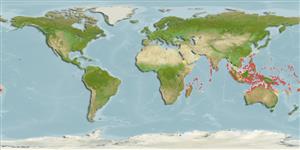>
Blenniiformes (Blennies) >
Blenniidae (Combtooth blennies) > Salariinae
Etymology: Cirripectes: Latin, cirrus = curl fringe + Greek, pektos, -e, -on = made of several parts solidly united (Ref. 45335); perustus: From possibly the bright red and yellow color of the male holotype and paratype..
More on author: Smith.
Environment: milieu / climate zone / depth range / distribution range
ນິເວດວິທະຍາ
ສັດທະເລ ກ່ຽວກັນຫີນ; ລະດັບຄວາມເລິກ 0 - 25 m (Ref. 529). Tropical; 30°N - 30°S
Indo-Pacific: Kenya to Taiwan and Kiribati; Palau, Yap, and Ifaluk in Micronesia. Likely to occur in Seychelles (Ref. 1623).
Length at first maturity / ຂະໜາດ / ນ້ຳໜັກ / Age
Maturity: Lm ?, range 5 - ? cm
Max length : 8.2 cm SL ຕົວຜູ້/ບໍ່ມີເພດ; (Ref. 529)
ຄີ (ໜາມ)ແຂງຢູ່ຫຼັງປາ (ທັງໝົດ) : 11 - 12; ຄີຫຼັງຂອງປາ (ຄີອ່ອນ) (ທັງໝົດ) : 14 - 15; ຄີ(ໜາມ) ແຂງຢູ່ຄີກົ້ນປາ
ກຸ່ມປາກະດູກແຂງ
ຄວາມຖີ່ຂອງກຸ່ມຖ່າຍທອດພັນ
ປາທີ່ມີການເຄື່ອນຍ້າຍຈາກທະເລໄປຫານ້ຳຈືດ ແລະນ້ຳຈືດຫາທະເລ
ປາທີ່ມີການເຄື່ອນຍ້າຍຈາກທະເລແລະໄປໄຂ່ຢູ່ນ້ຳຈືດ
ຄີກົ້ນຂອງປາ
ສັດທີ່ມີກະດູກສັນຫັຼງ
ການຖ່າຍທອດທາງກຳມະພັນຈາກພໍ່ແມ່ຫາລູກ: 2; ຄີກົ້ນຂອງປາ: 14 - 16; ສັດທີ່ມີກະດູກສັນຫຼັງ: 30 - 31. Diagnosis: Dorsal fin XII, 14, membrane attached to caudal fin, entire, first spine more or less the same height as second; anal fin II, 15; pectoral rays 15; pelvic fin I, 3; caudal fin procurrent rays 10-12. Vertebrae 10 + 20. LL, without scales and scalelike flaps; LL tubes 0-3, canal ends below dorsal ray 5-11. Lower lip smooth mesially, plicate laterally. Upper lip crenulae 36-48. Gill rakers 23-28. Cephalic sensory pore system simple. Midsnout pores present. Cirri, supraorbital 6-23, nasal 5-25; nuchal cirri 30 to 46, divided into 3-4 groups, 3-group resulting from fusion of bases of dorsalmost groups at apex of nape, 4-group condition has dorsalmost groups meeting or overlapping. Body depth at anal-fin origin 3.2-3.5 in SL. Pectoral with 5 ventralmost rays red-tipped; iris with yellow-colored oval, oriented almost vertically, centered around pupil, rest of iris silvery white. Female head and body grey to yellowish brown with spots red becoming dark brown posteriorly; with pale diagonal stripe from upper lip to nape, across orbit; pectoral fins brown. Male unspotted, bicolored yellow anteriorly and reddish brown posteriorly; pectoral fins yellow (Ref. 529, 90102, 37816).
Facultative air-breathing (Ref. 126274); Adults inhabit shallow seaward reefs, from the intertidal zone to 25 m depth (Ref. 9710, 529). Oviparous. Eggs are demersal and adhesive (Ref. 205), and are attached to the substrate via a filamentous, adhesive pad or pedestal (Ref. 94114). Larvae are planktonic, often found in shallow, coastal waters (Ref. 94114).
Life cycle and mating behavior
Maturities | ການສືບພັນ | Spawnings | Egg(s) | Fecundities | ຕົວອ່ອນ
Oviparous, distinct pairing (Ref. 205). Urogenital orifice of male genital papilla located basally between 2 widely separated slender filaments on a fleshy swelling behind anus; testes bulbous with length equal to its width (Ref. 529).
Williams, J.T., 1988. Revision and phylogenetic relationships of the blenniid fish genus Cirripectes. Indo-Pac. Fish. (17):78 p. (Ref. 529)
IUCN Red List Status (Ref. 130435)
Threat to humans
Harmless
Human uses
ການປະມົງ: ທີ່ບໍ່ມີຄວາມສົນໃຈ
ເຄື່ອງມື
Special reports
Download XML
ແຫຼ່ງອີນເຕີເນັດ
Estimates based on models
Preferred temperature (Ref.
123201): 26.3 - 29.3, mean 28.6 °C (based on 2456 cells).
Phylogenetic diversity index (Ref.
82804): PD
50 = 0.5000 [Uniqueness, from 0.5 = low to 2.0 = high].
Bayesian length-weight: a=0.01072 (0.00480 - 0.02393), b=3.01 (2.82 - 3.20), in cm total length, based on LWR estimates for this (Sub)family-body shape (Ref.
93245).
ຊັ້ນເຂດຮ້ອນ (Ref.
69278): 2.0 ±0.00 se; based on food items.
ຄວາມຢືດຢຸ່ນ (Ref.
120179): ສູງ, ປະຊາກອນຕຳ່ສຸດທີ່ໃຊ້ເວລາສອງໜ້ອຍກວ່າ 15 ເດືອນ (Preliminary K or Fecundity.).
Fishing Vulnerability (Ref.
59153): Low vulnerability (10 of 100).
Nutrients (Ref.
124155): Calcium = 148 [76, 260] mg/100g; Iron = 0.94 [0.56, 1.55] mg/100g; Protein = 18.3 [17.1, 19.3] %; Omega3 = 0.14 [0.08, 0.23] g/100g; Selenium = 22.4 [12.3, 44.2] μg/100g; VitaminA = 129 [37, 454] μg/100g; Zinc = 2.66 [1.79, 3.81] mg/100g (wet weight);
